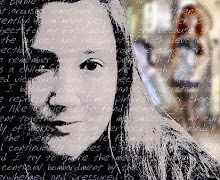Photo Collage:
Matt Manley is an illustrator and Tree Book is digital in the end, but is built using a foundation of traditional painting and drawing. The larger figurative elements are photographed oil paintings and overlayed with textures created both by hand and by scanning photographs. The photographs are used to support the image, and not dominate the work.
I particularly like his work because of the peaceful quality of the subject matter, and this image conveys a message of exploring the thought process of creativity and growth.

Joanna Goodrich Whitley uses abstraction suggested by nature as a starting point. Using a camera to look deeply at her surroundings, she finds abstraction in chance composition from life. She then juxtaposes the sharpness of the photographic image with texture and brush stroke of paint, creating an optical illusion. Her paintings evoke the mood of tranquility and beauty. In this piece, Silver Creek Pool, CO I think she is successful in blurring the line between photography and the traditional fine art medium of paint. It is an image that I could imaging being printed on a large canvas to envelop the viewer into the feeling of tranquilty.

Photo Montage:
Madalina Lordache-Levy’s image Rain Spell is composed of many photographs, combined to create a picture that is no documentary recording, but a frame in a story, a snapshot of an image lit by imagination, by memory, or by thought. The result is an image with photorealistic qualities and the feel of a painting.
I really like her approach, as she isn’t trying to convey a message, but rather, invite the viewer into her mind as she conveys a story. The image shows elements that can be viewed as almost a surrealist landscape, which makes it a montage, as opposed to a collage.

Sean Hillen’s work The Goddess Appears in Newry, Easter 1993 conveys his ideas and impression of a soldier being visited by Mary. He views his work as a statement “about how reality is constructed, about the possibility or likelihood that we don't agree on it, and how multiple interpretations of reality don't necessarily negate each other.”
It’s an interesting piece, as it definitely stops me in my tracks. I think any image that uses religious icons and military imagery is loaded for interpretation and asking for a reaction. I definitely think he gets his message across here. While the flowers are placed in a cross-like shape, I feel this is a montage and not a collage because the space works almost an as instillation.


No comments:
Post a Comment